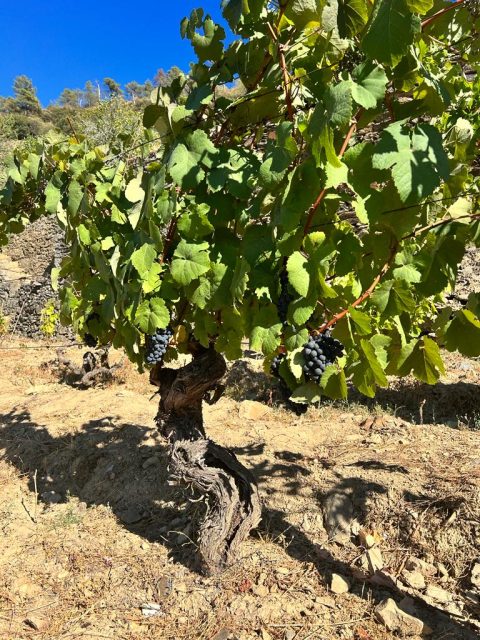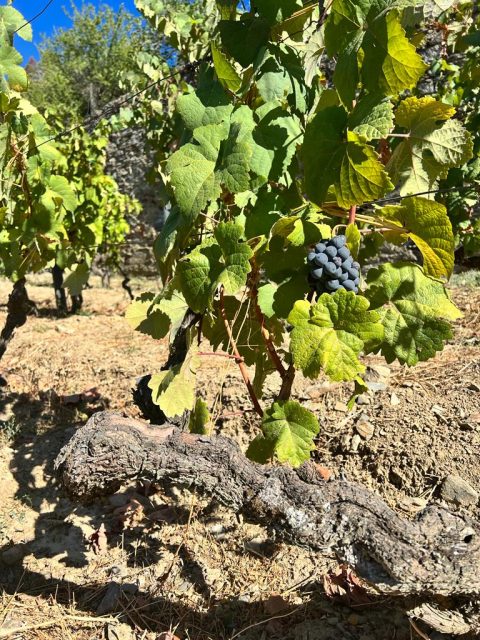This website uses cookies so that we can provide you with the best user experience possible. Cookie information is stored in your browser and performs functions such as recognising you when you return to our website and helping our team to understand which sections of the website you find most interesting and useful.
Hot, dry, low-yielding vintage in Douro could produce exceptional Ports
Extreme heat and drought in the Port and wine producing region of the Douro are likely to produce an extremely small vintage, although some exceptional wines are expected from this year’s harvest – which is starting now.

It’s been a year of heat waves and very little rainfall – more than 70% lower than the 30-year average – that will, as harvesting starts in earnest today in the Douro, ensure that yields in 2022 will be dramatically reduced.
Indeed, such conditions, which come on the back of three years of lower-than-average rainfall, are creating concern for Port- and winemakers in the region, who are seeing vineyards suffer, while the resulting reduced yields from a hot, dry and windy growing season will push up the price of production, on the back of other inflationary pressures.
Nevertheless, for those sites with old, established vines that are better placed to cope with climatic extremes, it is thought that the wines, and Ports that will be made from them, will be extremely good.
Speaking to the drinks business last week from his vineyards in the Pinhão valley, managing director at Quinta do Noval, Christian Seely, said that this was a low-yielding and early year – with harvesting at the property starting last week for white grapes for making table wines.
Due to the heat and low rainfall he said that the bunches are small, before commenting, “but when you taste the grapes, the juices are very concentrated, and very good, and our feeling at this stage is that the wines will be great for reds, whites and Port, but there won’t be many of them.”
Continuing, he said, “It is a similar profile to 2017, when we had extreme heat and little rainfall – which gave us a lot of worry at the time – but when we made and tasted the wines we realised the wines where fresh and balanced.”
As a result, he said that he believed 2022 would be like 2017 at Quinta do Noval – a year when the estate produced “exceptional and very balanced wines and Port.”
Adrian Bridge, CEO at Taylor Fladgate, was similarly enthusiastic about the quality potential at the top end, commenting that “fantastic wines could be made” from this year’s harvest from, for example, the producer’s prized Quinta de Vargellas, where “the old vines have done very well”.
Continuing, he said the resulting Ports from such a place could be on a par with the 2004 vintage, noting that an old vine for Taylor Fladgate refers to one that was planted 80 years ago or more.
Meanwhile, head winemaker at Symington Family Estates, Charles Symington, also said that this year’s harvest could produce brilliant results.
“‘The quality potential for this vintage is considerable due to the low yields and small berries, should conditions allow for final ripening; small quantities of exceptional wine could be made,” he said.

However, considering the longer term, there is concern among the producers in the Douro, should such conditions become the norm.
“The occasional hot dry year is not a disaster and can produce remarkable, memorable wines: ‘45 and ‘17 had that sort of profile and both of them produced some of the most remarkable vintage Ports ever produced – and in 2017, remarkable red wines too, to my surprise,” said Seely.
Continuing he said, “So I’m not worried about this year, but I am worried about the next.”
Why? While 2017 was followed by an unusually wet spring in 2018, allowing the vines to recover from the drought stress, Seely not only noted that 2022 has been preceded by a series of dry years, but should it not be followed by high levels of rainfall this winter to replenish soil water, then more vulnerable, younger vines could die in 2023.
Irrigation, while allowed when there is very little rainfall, and “can be helpful in certain places”, is “not a blanket solution” said Seely, because “there is not enough water”.
Already, the negative impact of the drought is being felt across the region. “I believe that this is going to be one of the lowest yielding harvests ever in the Douro,” said former chairman of Symington Family Estates, Paul Symington, during a conversation with db last week. Continuing he said, “Winemakers are going to get a surprise when they start to receive grapes into the wineries; there is little juice in the berries.”
Indeed, Bridge told db that such is the thickness of the skins in this year’s berries that a lot more grapes will be needed to make the same amount of Port.
“You normally need 750 kilos of grapes to make a pipe of Port, but his year, it will be 850-900 kilos,” he said.
“You will need much more weight for the same amount of juice, so there will be a lot of colour, but there is also the risk of raisin-like flavours, so we will have to be careful with the selection,” he added.
While commenting on the lack of rainfall, he said that this was exacerbated by a combination of heat and wind this year. “The wind normally picks up at 6pm, but at 2pm it has been whistling up the [Douro] valley – having a hair dryer effect on the vines, so the grapes are shrinking,” he recorded.
“In west-facing vineyards, many of the grapes are raisined because of the heat, but eastern or northerly aspects or those in valleys where there is shadowing, have good grapes,” he added.
Paul Symington said that the yield reduction this year would lead to “a shock” when producers see how little juice is coming out of the berries, as well as, he predicted “a big price hike”. Looking back over the Douro’s history, he said that the decrease in production from this year’s harvest could be of the same magnitude as that suffered by the region when phylloxera started affecting the vines in the 1870s.
Further commenting on the situation, he said that he was grateful that Symington Family Estates had “invested significantly in irrigation” in some of its vineyards – although the majority are dry-farmed.
But he also said that the varied terrain and scale of the Douro wine region meant that in the longer term there were ways to overcome the threat of a warmer and drier climate.
“On the positive side, the Douro is a large region – 43,600 hectares – and it is very mountainous. We have vineyards between 110 meters above sea level and all the way up to 600 meters and more. The higher vineyards are much cooler and can cope better with the heat. This altitude variance is unlike virtually any other wine region in the world. In fact no major wine region has this altitude variance on this scale. Our geography certainly brings huge challenges in terms of erosion and cost of building and maintaining vineyards, but it does give us a great defence and opportunity to fight climate change. In addition the Baixo Corgo is much cooler and more influenced by the Atlantic coastal climate and therefore cooler,” he said.
Finally, commenting on what he is witnessing in the Douro this year, he concluded, “There is no doubt that the impact from climate change has now arrived. Long predicted, it is now a full reality, and I hear the same story from vineyards right across southern Europe.”
Paul Symington provided db with some data that has been taken from the producer’s measuring equipment at Quinta do Bomfim, which, he said, exactly reflects the official Government data, and is used by various research organisations:
- In 2019 it rained 22% less than the 30 year average.
- In 2020 it rained 30% less than average.
- In 2021 it rained 29% less than average.
- In 2022, from 1 Jan to 31 July, there has been just 110.8mm at Bomfim against the 30 year average of 377mm. This is minus 71%. (Paul said, “110 mm is what we would normally expect in February every year but this is all that has fallen over the first 7 months, and after three very dry years”).

